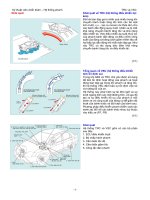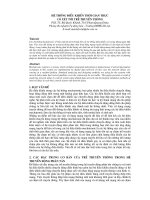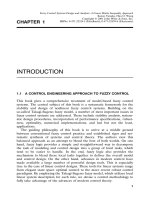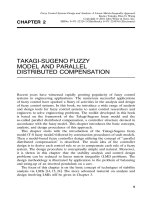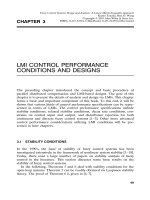Tài liệu Hệ thống điều khiển mờ - Thiết kế và phân tích P14 pdf
Bạn đang xem bản rút gọn của tài liệu. Xem và tải ngay bản đầy đủ của tài liệu tại đây (714.45 KB, 13 trang )
Fuzzy Control Systems Design and Analysis: A Linear Matrix Inequality Approach
Kazuo Tanaka, Hua O. Wang
Copyright ᮊ 2001 John Wiley & Sons, Inc.
Ž. Ž .
ISBNs: 0-471-32324-1 Hardback ; 0-471-22459-6 Electronic
CHAPTER 14
T-S FUZZY MODEL AS
UNIVERSAL APPROXIMATOR
In this chapter, we present two results concerning the fuzzy modeling and
wx
control of nonlinear systems 1 . First, we prove that any smooth nonlinear
control systems can be approximated by Takagi-Sugeno fuzzy models with
linear rule consequence. Then, we prove that any smooth nonlinear state
feedback controller can be approximated by the parallel distributed compen-
Ž.
sation PDC controller.
Ž. wx
Among various fuzzy modeling themes, the Takagi-Sugeno T-S model 2
has been one of the most popular modeling frameworks. A general T-S
model employs an affine model with a constant term in the consequent part
for each rule. This is often referred as an affine T-S model. In this book, we
focus on the special type of T-S fuzzy model in which the consequent part for
Ž.
each rule is represented by a linear model without a constant term . We
refer to this type of T-S fuzzy model as a T-S model with linear rule
consequence, or simply a linear T-S model. As evident throughout this book,
the appeal of a T-S model with linear rule consequence is that it renders
itself naturally to Lyapunov based system analysis and design techniques
wx
12, 15 . A commonly held view is that a T-S model with linear rule conse-
quence has limited capability in representing a nonlinear system in compari-
wx
son with an affine T-S model 9 .
wx
In Chapter 2, the PDC controller structure was introduced 11, 12 . This
structure utilizes a fuzzy state feedback controller which mirrors the struc-
ture of the associated T-S model with linear rule consequence. As shown
throughout this book, T-S models together with PDC controllers form a
powerful framework for fuzzy control systems resulting in many successful
wx
applications 10, 13, 14 .
277
T-S FUZZY MODEL AS UNIVERSAL APPROXIMATOR
278
In this chapter, we attempt to address the fundamental capabilities of T-S
models with linear rule consequence and PDC controllers. To this end, two
results are presented. The first result is that a linear Takagi-Sugeno fuzzy
model can be a universal approximator of any smooth nonlinear control
system. It has been known that smooth nonlinear dynamic systems can be
approximated by T-S models with affine models as fuzzy rule consequences
wx
4, 7 . However, most results on stability analysis and controller design of T-S
models are based on T-S models with linear rule consequence. The question
needed to be addressed is: ‘‘Is it possible to approximate any smooth
nonlinear systems with Takagi-Sugeno models having linear models as rule
wx
consequences?’’ Reference 6 gave an answer to this question for the simple
one-dimensional case. This chapter tries to answer this question for the
n-dimensional nonlinear dynamic system by constructing T-S model to ap-
proximate the original nonlinear system. The answer is yes. That is, the
original vector field plus its velocity can be accurately approximated if
enough fuzzy rules are used.
The second result is that the PDC controller can be a universal approxi-
mator of any nonlinear state feedback controller. Therefore linear T-S
models and PDC controllers together provide a universal framework for the
modeling and control of nonlinear control systems.
In this chapter, ޒ
n
is used to denote the n-dimensional vector spaces of
real vectors; C
m
is used to represent the set of n-dimension functions whose
n
mth derivative is continuous on the defined region; x stands for the ith
i
55
component of vector x and stands for the standard vector norm or matrix
Ž. <<
norm; Ox is the set of numbers y such that yrx - M, where M is a
constant.; and Ý is used to represent the summation with all
jj ... j
12 n
the possible combinations of j , j ,..., j . We will often drop the x and
12 n
just write h , but it should be kept in mind that h ’s are functions of the
ii
variable x.
14.1 APPROXIMATION OF NONLINEAR FUNCTIONS
USING LINEAR T-S SYSTEMS
14.1.1 Linear T-S Fuzzy Systems
The main feature of linear Takagi-Sugeno fuzzy systems is to express the
Ž.
local properties of each fuzzy implication rule by a linear function. The
overall fuzzy system is achieved by fuzzy ‘‘blending’’ of these linear functions.
Specifically, the linear Takagi-Sugeno fuzzy system is of the following form:
Rule i
IF x is M иии and x is M ,
1 i1 nin
THEN y s ax,
i
APPROXIMATION OF NONLINEAR FUNCTIONS USING LINEAR T-S SYSTEMS
279
T
wx
where x s x , x ,..., x are the function variables; i s 1, 2, . . . , r and r is
12 n
the number of IF-THEN rules; and M are fuzzy sets. The linear function
ij
y s axis the consequence of the ith IF-THEN rule, where a g ޒ
1=n
.
i i
The possibility that the ith rule will fire is given by the product of all the
membership functions associated with the ith rule:
n
hxs ⌸ Mx.
Ž. Ž .
iijj
j
s1
Ž.
We will assume that h ’s have already been normalized, that is, hxG 0 and
ii
r
Ž.
Ý hxs 1. Then by using the center-of-gravity method for defuzzifica-
is1 i
tion, we can represent the T-S system as
r
ˆ
y s fxs hxax.14.1
Ž. Ž. Ž .
Ý
ii
i
s1
The summation process associated with the center of gravity defuzzifica-
Ž.
tion in system 14.1 can also be viewed as an interpolation between the
functions axbased on the value of the parameter x.
i
14.1.2 Construction Procedure of T-S Fuzzy Systems
Ž.
n
Suppose that the nonlinear function fx: ޒ ™ ޒ is defined over the
compact region D ; ޒ
n
with the following assumptions:
Ž.
1. f 0 s 0.
2. f g C
2
. Therefore, f,
Ѩ
fr
Ѩ
x, and
Ѩ
2
fr
Ѩ
x
2
are continuous and there-
1
fore bounded over D.
ˆ
r
Ž. Ž.
Next, we will construct the T-S system fxs Ý hxaxto approxi-
is1 ii
Ž. Ž. Ž.
mate fx. The objective is to make the approximation error exs fxy
ˆ
Ž.
fx and its derivative
Ѩ
er
Ѩ
x small for all x g D.
Construction Procedures:
Ä4
1. In region D s xx-
⑀
where
⑀
is a chosen positive number,
0 i 00
choose a s
Ѩ
fr
Ѩ
x
xs0
.
0
n
2. Define the projection operator P mapping ޒ to n y 1 dimensional
x
subspace ޒ
n
rx as
²:
y, x
Pys y y x.
x
2
x
wx
T
In region D _ D , choose x as j
⑀
j
⑀
... j
⑀
, where
⑀
is a
0 jj ... j 12 n
12 n
positive number and j are integers. Build the linear model a as
ijj... j
12 n
T-S FUZZY MODEL AS UNIVERSAL APPROXIMATOR
280
the solution of the following linear equations:
ax s fx ,14.2
Ž. Ž.
jj ... jjj... jjj... j
12 n 12 n 12 n
Ѩ
f
aP s P .14.3
Ž.
xx
jj ... jjj... j
jj ... j
12 n 12 n
12 n
x
Ѩ
x
jj ... j
12 n
Ž.Ž.
For fixed x , 14.2 ᎐ 14.3 are n linear equations with the compo-
jj ... j
12 n
ˆ
Ž.
nent of a as the variables. Equation 14.2 implies that f and f
jj ... j
12 n
Ž.
have the same value at point x . Equation 14.3 implies that
jj ... j
12 n
a agree with
Ѩ
fr
Ѩ
x in the n y 1 dimensional space ޒ
n
rx .
jj ... j jj ... j
12 n 12 n
They are always solvable since x and P are independent of each other,
wx
that is, the matrices xPx are always invertible.
jj ... jjj... j
12 n 12 n
3. Choose the fuzzy rules as following:
Rule 0
IF x is about 0 иии and x is about 0,
1 n
ˆ
Ž.
THEN fxs ax.
0
Rule j j . . . j
12 n
IF x is about j
⑀
иии and x is about j
⑀
,
11nn
ˆ
Ž.
THEN fxs ax.
jj ... j
12 n
Ž.
For Rule 0, choose the possibility of firing hxas 1 inside D and 0
00
Ž.
outside. The possibility of firing for the jj... j th rule is given by the
12 n
Ž.
product of all the membership functions associated with the jj... j th
12 n
rule:
n
hxs ⌸ Mx,14.4
Ž. Ž . Ž .
jj ... jji
12 ni
i
s1
where the membership function for x is given as
i
x y j
⑀
°
ii
1 y , x y j
⑀
-
⑀
,
~
ii
Mxs 14.5
Ž. Ž .
⑀
ji
i
¢
0, elsewhere.
Ž. Ž.
It is noted that hxhave already been normalized, that is, hx
jj ... jjj... j
12 n 12 n
Ž.
G 0 and Ý hxs 1.
jj ... jjj... j
12 n 12 n
ˆ
Ž.
Therefore, we can write fx as
ˆ
fxs haxq hax.14.6
Ž. Ž .
Ý
00 jj ... jjj... j
12 n 12 n
jj
... j
12
n
APPROXIMATION OF NONLINEAR FUNCTIONS USING LINEAR T-S SYSTEMS
281
Remark 42 It should be pointed out that the specific membership function
constructed above is only needed when we want to approximate both the
nonlinear function and its derivative. There will be much more freedom if we
only want to approximate the function itself.
14.1.3 Analysis of Approximation
In this subsection, we will prove the fact that any smooth nonlinear function
satisfying the assumptions outlined in the previous subsection can be approxi-
mated, to any degree of accuracy, using the linear T-S fuzzy systems con-
structed above. This fact forms the foundation of the two statements in this
chapter.
First, we divide region D _ D into many small regions:
0
D s xxg D, j
⑀
F x F j q 1
⑀
᭙i .
Ž.
Ä4
jj ... jiii
12 n
Ž.
In the following discussions, we concentrate on one such region D ,
jj ... j
12 n
which is shown in Figure 14.1, by assuming that x g D . From the
jj,..., j
12 n
construction procedure above, we know that only the fuzzy rules centered at
Ž.
the vertices of D can be activated at x. That is, hx/ 0 only if
jj ... jll...l
12 n 12 n
x is one of the vertex points of D .
ll ...ljj... j
12 n 12 n
ˆ
Ž. Ž. Ž.
Consider ex, the approximation error between fx and fx:
ex s fxy hxax
Ž. Ž. Ž.
Ý
jj ... jjj... j
12 n 12 n
jj
... j
12
n
s fxy hxax
Ž. Ž.
Ý
jj ... jjj... jjj... j
12 n 12 n 12 n
jj
... j
12
n
y hxaxy x
Ž. Ž .
Ý
jj ... jjj... jjj... j
12 n 12 n 12 n
jj
... j
12
n
Fig. 14.1 Projection of D on xx plane.
jj
... jii
12 n 12
